
If you’re reading this article, perhaps you have discovered you are about to add “human parent” to your already proud title of “cat parent.” Or maybe you just brought your new baby home from the hospital, and your cat has started acting out of character at home.
A new baby in the house is a massive change for everyone, both two and four-legged, and with that comes a unique set of challenges. It is a sad fact that some families do give up their cats when a new baby comes home. Often, this results from undesirable changes in the cat’s behavior that could have been avoided with appropriate preparation.
This article will explore what bringing your bundle of joy home can mean for your cat, how you can help prepare your cat for the big day, and how to make this big transition as easy as possible.
Bringing home a new baby can be emotionally challenging for everyone in the family, including your cat. Stress can be reduced significantly with appropriate preparation and strategies. Methods to make the transition easier include desensitizing your cat to baby smells and noises, providing safe places for your cat to retreat, and keeping introductions gradual.Key Takeaways
Do Cats Get Jealous of Babies?
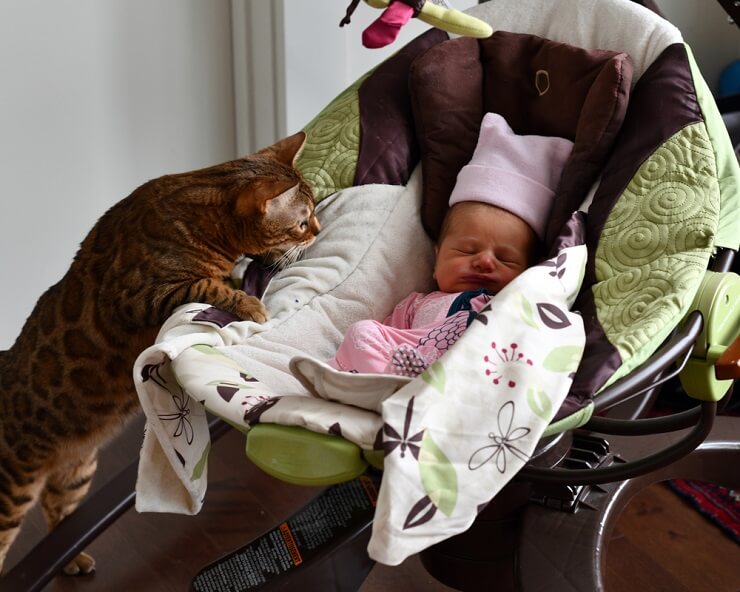
No one knows for sure if cats experience the complex emotion of jealousy.
Jealousy is a very complex human emotion; whether cats feel this emotion the same way we do is unknown. However, most cats certainly experience a spectrum of negative emotions on the arrival of a newborn baby, some of which are comparable to jealousy.
How your cat reacts to a new baby will likely depend greatly on their personality. If your cat uses your home like a hotel, they might not be bothered, providing their routine doesn’t change. However, clingy or affectionate cats might find this transition harder, and may need more support and preparation to avoid becoming very stressed or anxious.
Also Read: The 13 Most Affectionate Cat Breeds That Love to Cuddle
Signs of Stress in Cats

Behavior issues like scratching or going outside the litter box can often be traced back to stress.
Stress behavior in cats is complex and not always obvious. Signs of stress in cats include:
- Being withdrawn or hiding
- Becoming more grumpy
- Reluctance to use the litter tray, cat flap, or to come for cuddles
- Changes in appetite
- Scratching furniture
- Increased vocalization (meowing, hissing, or growling)
- Urinating or pooping outside of their litter tray
- Flattening their ears
- Wide pupils
- Crouched stance
- Excessive grooming
Some of these signs can also be attributable to medical disorders, so it’s important to discuss your cat’s symptoms with your veterinarian and get a clean bill of medical health before assuming a behavioral problem.
Keeping Everyone Safe
1. Will My Cat Hurt My Baby?
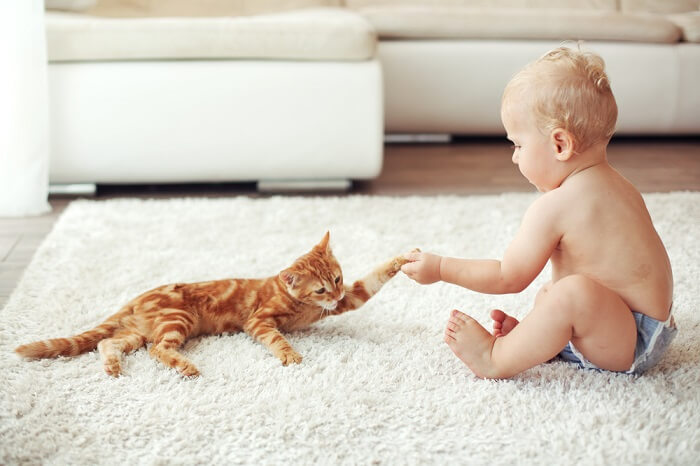
When properly introduced, cats and babies can become great friends.
Sadly, it is not an impossibility that your cat may react negatively to your newborn baby. This is especially true if a cat is forced to look at or be near the baby against their will. As your baby grows and begins to explore their environment, there is also the risk of an accidental fur grab or tail pull, which could cause even a well-mannered cat to react negatively.
Always supervise interactions between your cat and baby, even if your cat has never shown any signs of fear or aggression toward your baby. Crucially, never carry your cat to the baby to force them to interact. Allow your cat to choose whether they wish to be near the baby.
Also Read: How To Introduce A New Kitten To An Older Cat
2. Is It Safe To Let My Cat Sleep With My Baby?

It might look cute, but cats and babies should not sleep together.
There are many old wives’ tales of jealous cats plotting or scheming to suffocate babies. Rest assured that cats, despite this old-fashioned reputation, do not plot revenge. However, allowing your cat to sleep on or near your new baby is never safe. This is because of the risk of accidental suffocation of your baby.
Babies are like little radiators, and once your cat is accustomed to your baby at home, they may actively choose to snuggle up close to them for warmth. You might need to keep your cat shut out of the nursery, bedroom, or living space while the baby sleeps. This can be hard to understand for some cats if it happens very suddenly.
Get your cat used to being shut out of rooms they usually have access to before the baby comes home, so you can help them more easily adjust to this transition.
Also Read: Why Does My Cat Sleep On Me?
3. Are There Any Diseases My Cat Might Give My Baby?
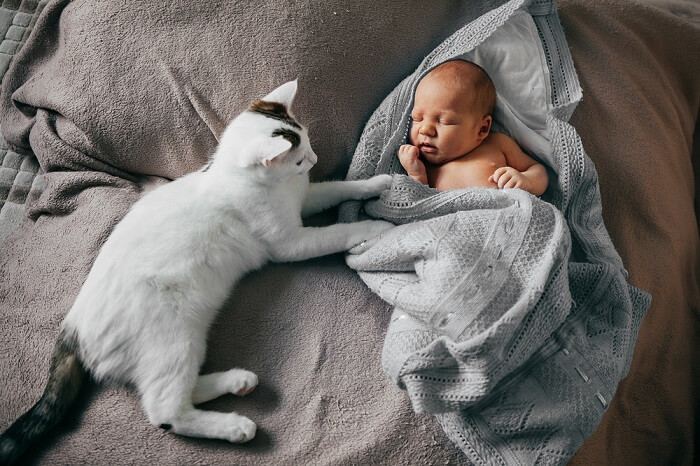
Proper hygiene is essential to prevent transmission of harmful organisms.
It is important to note that some infections carried by cats can be passed to your baby. Babies are more vulnerable to diseases because of their immature immune systems.
Proper hygiene, preventative medications, and respect for your cat’s boundaries can prevent transmission, but always talk to your pediatrician and veterinarian to ensure you have the most up-to-date advice. The main considerations are:
Toxoplasmosis: This is a type of parasite that can be passed from cats to humans via cat feces. Babies and children can be affected by the parasite. It also is a significant risk for pregnant women and can lead to miscarriage or congenital problems for the unborn baby.
The best means of avoiding the risk are not handling cat feces (ask your partner or a family member to clean the litter tray when pregnant) and not allowing babies or children to touch litter.
If this isn’t an option, wear rubber gloves, and wash your hands thoroughly after cleaning the litter box. If you grow vegetables in your garden, wash them thoroughly in case cats have used the growing area to go potty.
Also Read: My Cat Doesn’t Finish Pooping In Litter Box: Is This Normal?
Other Parasites: It is essential to ensure your cat is up to date with routine prophylactic flea, tick, and worming treatments. Babies and children are not cautious about hygiene, and roundworm infections are common.
Though thankfully treatable, prevention is always the best precaution. Depending on your country of residence, fleas and ticks can carry some nasty blood-borne infections. Even if your cat is indoor only, they can still be affected by fleas or ticks tracked in by their human housemates.
Rabies: Depending on your country of residence, ensure your cat is up to date with their rabies shots and always try to avoid a situation that may lead to your cat biting your child.
Cat bites and scratches: Cat bites can be very serious, irrespective of age, due to the bacteria present in a cat’s mouth. Cat bites often require prompt antibiotic treatment. Additionally, cat scratches can lead to a severe infection called cat scratch fever or cat scratch disease. This is a result of a bacteria called Bartonella henselae. If your cat has bitten or scratched your baby, always seek prompt medical attention.
Raw Feeding: With no scientific evidence to support it at this time, the jury is still out as to whether there is genuinely a benefit to the growing trend for raw feeding domestic pets. However, we know that raw feeding increases harmful and drug-resistant bacteria in your cat’s feces. The current CDC guidelines advise against raw feeding and state that babies and children are more at risk from this practice.
If you choose to feed raw, wash your hands thoroughly after feeding or petting your cat, and ideally, prevent your cat from interacting with your baby. Do not handle raw pet food while pregnant if possible.
How To Prepare Your Cat for a New Baby
You can take several steps to help prepare your cat for the new arrival:
1. Establish a New Routine
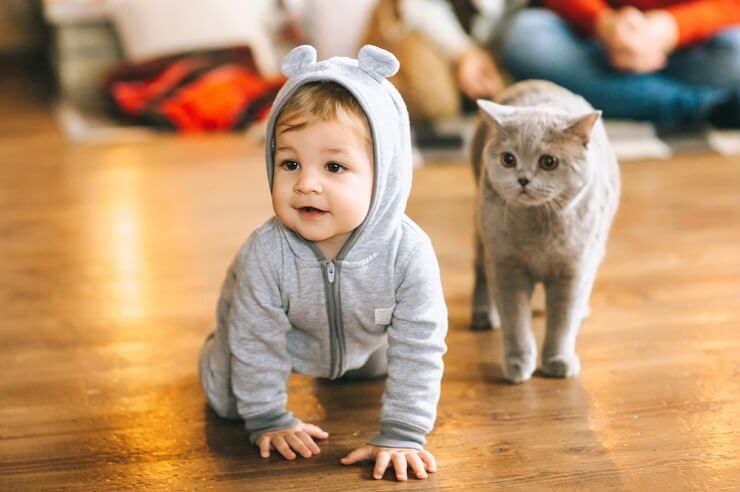
Allow you cat to interact with your baby on their terms, or to avoid interaction if they prefer.
It is a given, that life changes hugely when a new baby comes home, no matter how many plans we make. This can be very challenging for your cat, who is likely a creature of habit and not a fan of any change to their routine.
To help your cat adapt, establish a new routine well before bringing your baby home. Allow them to investigate, smell, and explore the new things you bring into the house, such as cribs and strollers. Let them into the new nursery, so they are no longer curious about the room they are not allowed to enter.
As your baby’s due date approaches, gradually reduce the time spent cuddling, grooming, or playing with your cat (the reality of having a newborn is you will have much less time available). Instead, introduce a dedicated time for your cat to provide them with one-on-one love and attention.
If you have older kids, especially if they have a good relationship with your cat, consider entrusting them with the role of maintaining kitty cuddle time, so your cat doesn’t feel they are missing out.
Also Read: Why Does My Cat Follow Me Everywhere?
2. Desensitization
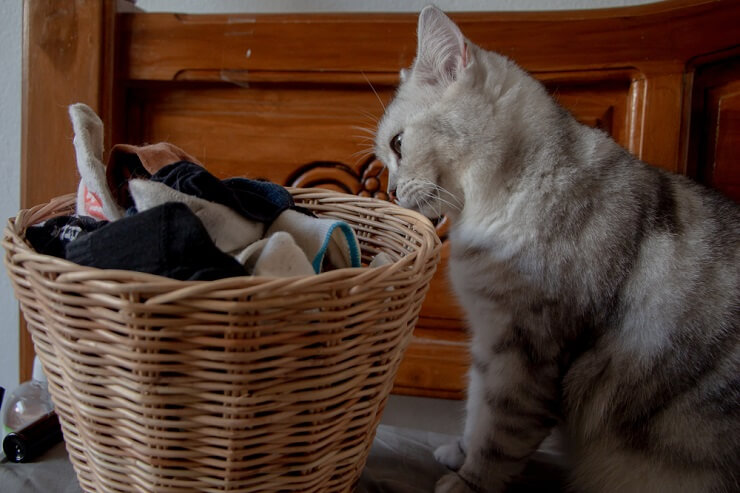
Before baby comes home, play recordings of a baby crying at low volume while giving your cat treats or pets.
Babies make noise; this is no secret. However, introducing this noisy, wailing, and fussy little creature can be pretty upsetting for your cat. It is possible to gradually desensitize your cat to a baby’s cries by playing recordings on a low volume while providing positive rewards (such as treats or pets) to your cat.
Depending on the cat, this can be a relatively quick process or take several weeks. Therefore, it is best to start early.
Similarly, a lot of new smells come with a baby. Cats have a great sense of smell, so new scents can confuse them. Start to use some of the new baby products, with positive reinforcement as needed, so the smells aren’t alien to your cat.
If you know someone with a newborn, ask if you can borrow some used clothes or blankets so your cat can get used to newborn smells.
Also Read: 6 Reasons Your Cat Makes Weird Noises At Night
3. Create Safe Spaces
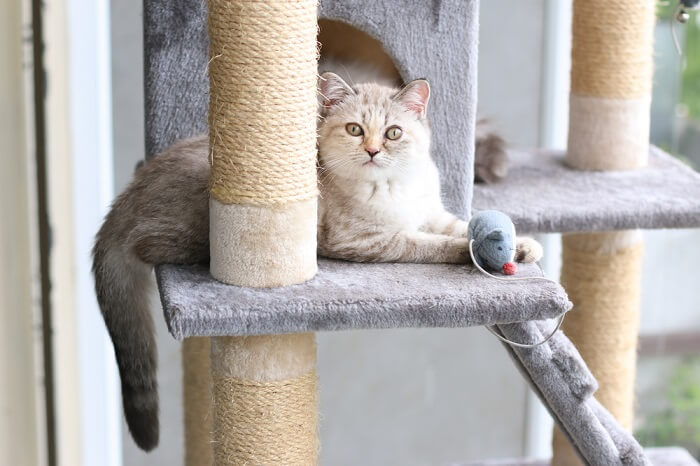
Cats feel more comfortable when they know they have a safe place to retreat.
Your cat must have a safe, child-free space to go to. Ensure this is quiet, out of the way, and within easy access to your cat’s resources such as food and water bowls and litter box. If your cat chooses to hide away, do not force them to be sociable. Give them space to adjust and adapt on their own timeline to avoid added stress and anxiety.
4. Pheromone Therapy
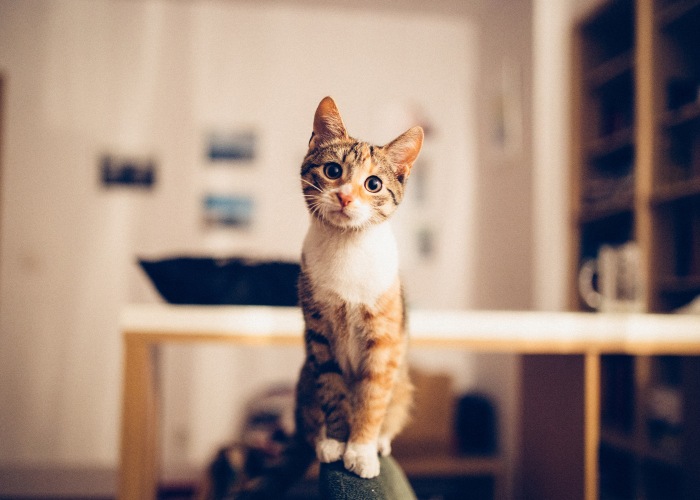
Pheromone sprays or plug-in diffusers can help a cat feel calmer and less stressed.
Some great feline pheromone products are on the market as both plug-in and spray options. Pheromones are a natural type of chemical communication signal, and some of them can enhance the feeling of calm in cats.
These products work by releasing comforting hormones that reduce your cat’s feelings of stress and anxiety. There are several types of products on the market, so if you are unsure which is the right one for your cat, ask your veterinarian for advice.
Also Read: What Does Catnip Do To Cats & Why Cats Like It?
How To Introduce a New Baby to Your Cat
1. Bring Home Your Baby’s Scent Ahead of Time

While you’re still at the hospital, send home one of the baby’s blankets or a shirt for your cat to investigate.
Bringing home a blanket or item of clothing with your baby’s scent can help your cat become familiar with your new arrival ahead of time. Don’t stress if this isn’t possible before your baby comes home. You can always do this with your cat and baby in different rooms.
2. Make Introductions Gradual

Let your cat decide if and when they feel comfortable approaching the baby.
Your cat will naturally be unsure about the new baby. Under no circumstances should you carry your cat to your baby and force them to look or interact. Allow the introductions to happen on your cat’s terms.
This might mean you never get that social media-worthy cuddling moment, and that’s OK. For some cats, tolerance may be the most loving interaction attainable; others may choose never to interact.
3. Don’t Ignore Your Cat
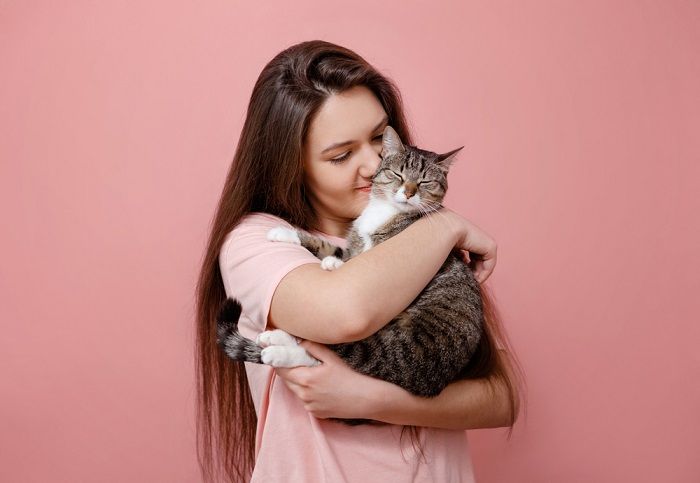
Carve out some time to cuddle and play with your cat every day.
Life with a newborn is hectic and stressful. To help ease this big change for your cat, make time for some dedicated kitty cuddles, providing it’s what your cat wants. If your cat seeks your comfort or attention, make sure you reciprocate with lots of cuddling.
If, despite your best efforts, your cat is still struggling with the major life transition of a new baby joining the family, speak to your veterinarian. They will ensure your cat has a clean bill of medical health, refer you to a licensed veterinary behaviorist for advice, and help you traverse this new life stage with your cat.
Also Read: 5 Easy Tricks to Teach Your Cat According to a Cat Behaviorist
Final Thoughts
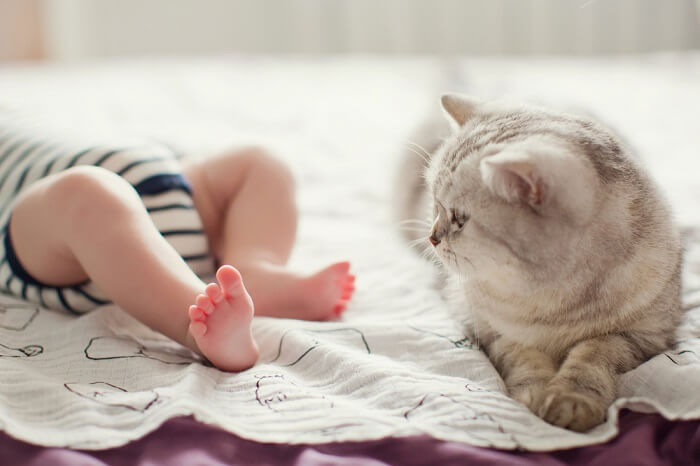
It might take some time, but most cats adjust to a new baby, and some even become lifelong friends.
A new baby means significant changes for two and four-legged family members alike. It can be emotionally challenging for your cat, but the stress can be reduced significantly with appropriate preparation. If, despite your best efforts, your cat is still struggling to adapt, speak to your veterinarian, who, alongside a licensed veterinary behaviorist if needed, can help you and your cat to traverse this new life stage together successfully.
Also Read: 5 Reasons To Adopt A Special Needs Cat
Frequently Asked Questions
How do I know if my cat is jealous of my baby?
Jealousy is a complex human emotion, but cats do certainly feel a range of negative feelings that may be akin to jealousy when a new baby is brought home. You may notice changes in your cat's behavior, such as becoming more withdrawn, more grumpy than usual, or changes in appetite or toileting habits.
How do cats react to newborn babies?
How your cat reacts to a new baby is likely to be affected by their personality. Some cats may take a new baby in stride, whereas others may become extremely stressed or anxious. Take steps to prepare your cat for your new arrival to minimize this anxiety.
Do cats adjust to babies?
Most cats can adjust to having a new baby at home. Helping prepare your cat for your new arrival can reduce the time this adjustment takes. Some cats need an extra helping hand, and speaking to your veterinarian can be a helpful first step in getting your cat used to their new normal.
Why is my cat hissing at my baby?
If your cat is hissing at your baby, they may be frightened or anxious. There are some measures you can take to help reduce this behavior outlined in the article above, but if these don't work, then talk to your veterinarian, who will be able to advise a licensed veterinary behaviorist if necessary.
-
CDC (2022) Pet Food Safety. Available at https://www.cdc.gov/healthy-pets/about/pet-food-safety.html?CDC_AAref_Val=https://www.cdc.gov/healthypets/keeping-pets-and-people-healthy/pet-food-safety.html . [Retrieved 16th August 2022]
-
Davies et al (2019) Raw diets for dogs and cat: a review, with particular reference to microbiological hazards. Journal of Small Animal Practice DOI https://doi.org/10.1111/jsap.13000 [Accessed 20th August 2022]







